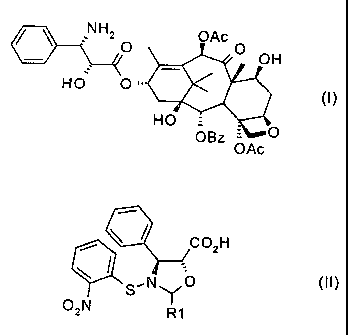Une partie des informations de ce site Web a été fournie par des sources externes. Le gouvernement du Canada n'assume aucune responsabilité concernant la précision, l'actualité ou la fiabilité des informations fournies par les sources externes. Les utilisateurs qui désirent employer cette information devraient consulter directement la source des informations. Le contenu fourni par les sources externes n'est pas assujetti aux exigences sur les langues officielles, la protection des renseignements personnels et l'accessibilité.
L'apparition de différences dans le texte et l'image des Revendications et de l'Abrégé dépend du moment auquel le document est publié. Les textes des Revendications et de l'Abrégé sont affichés :
| (12) Brevet: | (11) CA 2482131 |
|---|---|
| (54) Titre français: | PROCEDE SEMI-SYNTHETIQUE DE PREPARATION DE N-DEBENZOYLPACLITAXEL |
| (54) Titre anglais: | A SEMI-SYNTHETIC PROCESS FOR THE PREPARATION OF NDEBENZOYLPACLITAXEL |
| Statut: | Durée expirée - au-delà du délai suivant l'octroi |
| (51) Classification internationale des brevets (CIB): |
|
|---|---|
| (72) Inventeurs : |
|
| (73) Titulaires : |
|
| (71) Demandeurs : |
|
| (74) Agent: | KIRBY EADES GALE BAKER |
| (74) Co-agent: | |
| (45) Délivré: | 2012-07-17 |
| (86) Date de dépôt PCT: | 2003-03-24 |
| (87) Mise à la disponibilité du public: | 2003-10-23 |
| Requête d'examen: | 2008-03-07 |
| Licence disponible: | S.O. |
| Cédé au domaine public: | S.O. |
| (25) Langue des documents déposés: | Anglais |
| Traité de coopération en matière de brevets (PCT): | Oui |
|---|---|
| (86) Numéro de la demande PCT: | PCT/EP2003/003017 |
| (87) Numéro de publication internationale PCT: | EP2003003017 |
| (85) Entrée nationale: | 2004-10-08 |
| (30) Données de priorité de la demande: | ||||||
|---|---|---|---|---|---|---|
|
L'invention concerne un procédé de préparation de N-débenzoylpaclitaxel (I) par estérification de la baccatine III protégée en 7 avec un dérivé réactif d'acide carboxylique représenté par la formule générale (II), et par élimination des groupes protecteurs d'ester dans des conditions acides et en une seule étape. Dans la formule (II) R1 représente aryle or hétéroaryle. Le composé représenté par la formule (I) peut être avantageusement utilisé pour la préparation de paclitaxel et analogues.
A process for the preparation of N-debenzoylpaclitaxel (I) through
esterification of 7-protected baccatin III with a carboxylic acid reactive
derivative of general formula (II), and elimination of the ester-protecting
groups in acid conditions and in a single step. In formula (II) R1 is aryl or
heteroaryl. The compound of formula (I) can be conveniently used for the
preparation of paclitaxel and analogues.
Note : Les revendications sont présentées dans la langue officielle dans laquelle elles ont été soumises.
Note : Les descriptions sont présentées dans la langue officielle dans laquelle elles ont été soumises.

2024-08-01 : Dans le cadre de la transition vers les Brevets de nouvelle génération (BNG), la base de données sur les brevets canadiens (BDBC) contient désormais un Historique d'événement plus détaillé, qui reproduit le Journal des événements de notre nouvelle solution interne.
Veuillez noter que les événements débutant par « Inactive : » se réfèrent à des événements qui ne sont plus utilisés dans notre nouvelle solution interne.
Pour une meilleure compréhension de l'état de la demande ou brevet qui figure sur cette page, la rubrique Mise en garde , et les descriptions de Brevet , Historique d'événement , Taxes périodiques et Historique des paiements devraient être consultées.
| Description | Date |
|---|---|
| Inactive : Périmé (brevet - nouvelle loi) | 2023-03-24 |
| Représentant commun nommé | 2019-10-30 |
| Représentant commun nommé | 2019-10-30 |
| Requête pour le changement d'adresse ou de mode de correspondance reçue | 2018-01-09 |
| Accordé par délivrance | 2012-07-17 |
| Inactive : Page couverture publiée | 2012-07-16 |
| Préoctroi | 2012-05-04 |
| Inactive : Taxe finale reçue | 2012-05-04 |
| Un avis d'acceptation est envoyé | 2011-11-21 |
| Lettre envoyée | 2011-11-21 |
| Un avis d'acceptation est envoyé | 2011-11-21 |
| Inactive : Approuvée aux fins d'acceptation (AFA) | 2011-11-16 |
| Modification reçue - modification volontaire | 2011-08-12 |
| Rapport d'examen | 2011-04-20 |
| Modification reçue - modification volontaire | 2010-09-14 |
| Inactive : Dem. de l'examinateur par.30(2) Règles | 2010-05-18 |
| Modification reçue - modification volontaire | 2010-02-11 |
| Inactive : Dem. de l'examinateur par.30(2) Règles | 2009-08-19 |
| Lettre envoyée | 2008-05-05 |
| Requête d'examen reçue | 2008-03-07 |
| Exigences pour une requête d'examen - jugée conforme | 2008-03-07 |
| Toutes les exigences pour l'examen - jugée conforme | 2008-03-07 |
| Modification reçue - modification volontaire | 2008-03-07 |
| Inactive : Page couverture publiée | 2004-12-17 |
| Inactive : Notice - Entrée phase nat. - Pas de RE | 2004-12-15 |
| Lettre envoyée | 2004-12-15 |
| Demande reçue - PCT | 2004-11-09 |
| Exigences pour l'entrée dans la phase nationale - jugée conforme | 2004-10-08 |
| Demande publiée (accessible au public) | 2003-10-23 |
Il n'y a pas d'historique d'abandonnement
Le dernier paiement a été reçu le 2012-02-27
Avis : Si le paiement en totalité n'a pas été reçu au plus tard à la date indiquée, une taxe supplémentaire peut être imposée, soit une des taxes suivantes :
Les taxes sur les brevets sont ajustées au 1er janvier de chaque année. Les montants ci-dessus sont les montants actuels s'ils sont reçus au plus tard le 31 décembre de l'année en cours.
Veuillez vous référer à la page web des
taxes sur les brevets
de l'OPIC pour voir tous les montants actuels des taxes.
Les titulaires actuels et antérieures au dossier sont affichés en ordre alphabétique.
| Titulaires actuels au dossier |
|---|
| INDENA S.P.A. |
| Titulaires antérieures au dossier |
|---|
| EZIO BOMBARDELLI |
| GABRIELE FONTANA |